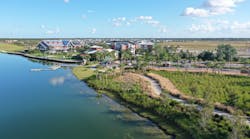With property five times the size of the island of Manhattan, Babcock Ranch Founder Syd Kitson set out to construct a sustainable, new town in Florida that worked with the environment. Located in Charlotte and Lee counties, Babcock Ranch is on the cutting edge of development as America’s first solar-powered town and operates one of the largest solar-plus-battery storage systems.
Mindful Development
Kitson announced his ambitious plan in 2005 when he and his team at Kitson & Partners purchased 91,000 acres (143 square miles) of Babcock Ranch for a town and preservation. The independent special district’s footprint is 18,000 acres. Preservation efforts include 9,000 acres of the 18,000 total, as well as 73,000 acres the State of Florida purchased from Kitson, equating to roughly 90% of the ranch’s original property.
“When we first started, we put together a series of initiatives that we thought were critical to be the most sustainable new town that’s ever been developed,” Kitson explained. “Our whole basis was to prove that a new town and the environment could work hand in hand.”
As a developer, Kitson recognized he impacts the environment, so Babcock Ranch was an opportunity to focus on sustainable, resilient and innovative practices to mitigate the environmental impact. However, building a town near a wetland while preserving those natural resources required research into the historical waterways of the land. There was also no clear-cutting of the native vegetation.
“Instead of fighting Mother Nature, we’re working with Mother Nature,” he said. “I found the natural flow ways of Babcock Ranch and we kept away from them. That has been a big part of our success over time.”
The builders created Innovation Way, a model park to explore the next era of home building using sustainable technology and innovations from new HVAC systems to gray water recycling. The end goal is to install the new systems in future development.
“Any time you innovate, it is hard,” Kitson said. “Usually when you’re innovating, you’re impacting someone else in some way and they’re not going to like that. That can create challenges along the way.”
Kitson worked alongside Florida Power & Light Company for eight years to incorporate renewable energy into the infrastructure. Almost 700,000 panels span 870 acres and produce 150 megawatts of energy. That energy can power 30,000 homes and is the emissions equivalent of removing 28,000 cars from the road annually.
Integrated and Resilient Energy
Part of what makes Babcock Ranch attractive is the commitment to renewable energy and the integration and accessibility of those resources for residents. An 840-acre solar panel farm is home to two solar energy centers, the FPL Babcock Ranch Solar Energy Center and the FPL Babcock Preserve Solar Energy Center, operated by the Babcock Ranch developer and Florida Power & Light.
Florida Power & Light sourced the panels and installed the solar-to-battery system and “solar trees.” Energy is discharged for over four hours and then switched to natural gas. Efforts are underway to increase the storage capacity to reduce the reliance on natural gas.
“Renewable energy is important to the future of our planet,” Kitson said. “It’s going to take time and we know that. We want to be part of those solutions, so giving people the opportunity to power up their cars and live their everyday lives with solar energy is important.”
The solar energy center's 680,000 solar panels generate 150 megawatts of clean, renewable energy that powers commercial and residential buildings. On average, Babcock Ranch homes are 24% more efficient than homes built to the Florida Energy Code. The National Renewable Energy Lab calculator estimates that 149 megawatts of photovoltaics (PVs) at Babcock Ranch’s latitude will produce 230,700,534 kWh annually. The average Florida home uses 13,704 kWh per year, and Babcock’s efficiency means the PV array can support 22,151 homes—the ranch will have 19,500 homes.
The average Energy Use Intensity for commercial buildings is 14.6 kWh per square foot, varying by use, so the array can support 1,890,961 square feet of commercial facilities. Commercial buildings and some homes are fitted with rooftop PVs, reducing the demand for the PV array.
When properly installed, Kitson said solar panels can withstand harsh weather phenomena as the energy center did through Category 3 and 4 hurricanes. The first test was Hurricane Ian, a Category 4 storm. No homes lost power, internet, or access to clean water.
Residents can connect to free Wi-Fi and the “solar trees” in Founder’s Square and the parks that allow people to charge their devices.
“The solar trees are cool looking, and people plug in their iPhones to charge them up,” he said. “Everyone thinks it’s cool how this tree is charging their devices and it’s great to be able to showcase this and have the community embrace it.”
Babcock Ranch also boasts one of the largest battery storage systems in the country, part of a solar-to-battery facility, which produces 10 megawatts. The electrons generated by the solar field go to the Babcock Ranch substation to power the community. The remaining energy goes to the grid.
“The 150 megawatts can power over 30,000 homes and it takes about [the equivalent of] 28,000 cars off the road annually,” Kitson said.
Each residence has access to 1 Gigabit with fiber connected to every home and business, a service included within the HOA fees. Dark fiber will eventually support the security needs of the police, fire and community patrol with license plate readers and cameras.
Residences also come pre-wired for EV charging stations in the garage, a requirement Kitson said is important to the community’s sustainability. Additionally, landscapes must use native plants and have limited square footage for grass lawns to preserve the ecosystem and reduce invasive species from disrupting the wetland’s habitat.
Florida Power & Light is currently building a solar education center adjacent to an observation tower to promote outreach.
Common city features rarely seen in Babcock Ranch are streetlights. Instead, there are roundabouts to maintain a continuous, slow traffic flow in the community.
While Babcock Ranch is unincorporated, Kitson expressed a commitment to navigate a governance structure that supports the place’s initiatives rather than a political agenda.
Future Development
Babcock Ranch has checked the box on many firsts on the sustainability front, with the project still ongoing. The commercial sector is under development as they finalize plans for a shopping center and office building constructed out of mass timber.
“We’re going to be like a living laboratory and we’re going to figure this stuff out,” he said. “We are building our own office building and we’re looking at how can we make this building carbon neutral while at the same time giving people a great work environment?”
Innovation Way 2.0 will explore 3D-printed homes and panels along with material usage that is less impactful to the environment.
They are also revisiting public transportation that began with an autonomous bus but was stopped during the COVID-19 pandemic.
Kitson noted, “If we’re going to continue to build new cities and towns, and when you look at the increase in population, we absolutely need to make sure we are preserving enough of the land so that we can live in harmony with our surroundings.”
The goal is for Babcock Ranch to function off the grid through innovative technology that stores enough power to run homes and businesses without negatively impacting the wetlands and habitats many animals also call home.
Syd Kitson was named Time's "Dreamer of the Year," an honor bestowed on a person who reinterprets possibilities and fosters stronger communities, now and into the future.
For more information about new EV charging networks for commercial applications, read our coverage by our sister publication Smart Buildings Technology here.


